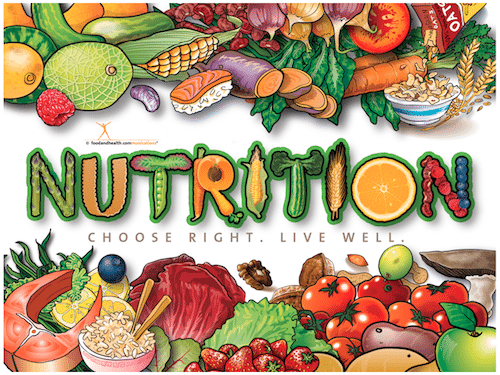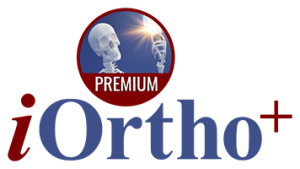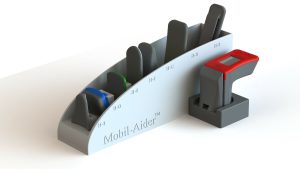Role of Nutrition in Orthopedics
BACK-STORY: For many years, I have been interested in the role of nutrition in healthcare. As an academic, I have tried to infuse this material into the various pathology and orthopedic courses I teach. I have always thought we spend too much time on “sick care” instead of “health care.” Thus, I assigned the DPT students a pathology paper to address the mechanism of injury, medical, rehab, and nutritional management, as well as the complications and prognosis. Five groups provided excellent information on the nutritional aspects of the orthopedic pathology. I asked their permission to share this information and acknowledged their names below. Thank you,

In the medical arena we seem to default to medication for the treatment of pathology. I appreciate the value of many medications, but they can have side effects and interact with other medications. In some cases, there may be nutritional supplements to help in the recovery of injuries without some of the side effects or interactions of prescription medications. Of course, supplements are not 100% risk free. Given their lack of regulation, one cannot be certain of the efficacy of a supplement. In addition, there are some medications that should not be taken with certain food or supplements. Chemicals in some foods or supplements can interfere with how the body metabolizes a drug. For example, kale should not be eaten when on blood thinners, antibiotics should not be taken with milk, and black licorice should not be eaten by people on glycosides. Likewise, ginkgo could increase bleeding risk when taken with warfarin and St John’s wort can decrease the effectiveness of some birth control. Yet, when exploring the evidence there are quite a few supplements that could be valuable for orthopedic pathology.
Almost all orthopedic injuries have some form of inflammation, at least in the beginning. Diets that can help to control the inflammatory response may be helpful. Conditions such as adhesive capsulitis can cause stiffness and pain that lasts for weeks. Osteoarthritis can be very debilitating. A diet with foods that have less inflammation-causing prostaglandins (PGE2), and more foods with anti-inflammatory prostaglandins (PGE1, PGE3) could be helpful.1 Omega 3 fatty acids found in fish oil supplements and in cold water-dwelling fish (e.g., salmon, mackerel) have been shown to reduce inflammation.2 A diet that is high in fruit (e.g. strawberries, blueberries, oranges) and vegetables (e.g., spinach, kale, collard greens) has also been associated with decreasing inflammation.3 An anti-inflammatory diet should feature foods that are rich in probiotics such as yogurt, kombucha, kefir and culture vegetables.4 Alternatively, decreasing foods with simple carbohydrates and saturated/trans fats that can trigger inflammation could be beneficial.
Probiotics are live bacteria/yeast and classified as “good” bacteria that live in our body to help promote better digestion and overall gut health. These include foods such as yogurt, kombucha, pickles, and some cheeses. Likewise, eating healthy fats like nuts, avocado and olive oil are another dietary recommendation. Extra virgin olive oil is believed to contain a chemical similar to ibuprofen, so may be a helpful addition to a diet. Supplements such as turmeric, omega-3 fatty acids, magnesium, glucosamine, chondroitin and CoQ10 may aid in mitigating inflammation. Chondroitin is one of the most common supplements taken since recent studies have found that it can prevent cartilage breakdown and stimulate repair mechanisms.5
Two vitamins have been studied for their relationship to carpal tunnel syndrome (CTS): B6 and D. Vitamin B6 plays a significant role in regulating many metabolic pathways of neuronal function including the production of neurotransmitters and the conversion of food into energy. One study examined the effects of vitamin B6 supplements in patients with mild to moderate CTS. The results of the study suggest that vitamin B6 supplements were effective in improving nocturnal pain severity, nocturnal awakening frequency due to pain and hand numbness, frequency and persistence of daily pain, hand numbness and weakness, hand tingling, and clumsiness when handling objects. The recommended dose was 120 mg/day.6
Carpal tunnel patients have been known to have increased amounts of vascular endothelial growth factors (VEGF). These factors are associated with increased vascular proliferation and inflammatory synovial fibrosis that may trigger the onset of the syndrome. Vitamin D is known to be a neuroactive steroid that suppresses these VEGFs and induces nerve growth factors that can help with prevention of neurological deficits. This vitamin is specifically said to have a role in neuroprotection and neurotrophism, which reduce neurological injuries and neurotoxicity and improve myelination and recovery after nervous system injuries.7
A study by Angeline et al (2013) examined the impact of vitamin D deficiency after surgical reattachment of the supraspinatus tendon in rats. The biomechanical and histological data suggested low vitamin D levels may also negatively affect early healing at the rotator cuff repair site.8
A randomized double-blind placebo-controlled study adding high dose vitamin D to analgesic regimens in patients with musculoskeletal pain was performed by Gendelman et al (2015).9 The results demonstrated that 4000 IU of vitamin D for patients with musculoskeletal pain may lead to a faster decline of consecutive visual analogue scores (VAS) and a decrease in the levels of inflammatory and pain-related cytokines. Hence, vitamin D has been linked to a reduction of “cytokine storms.”
Type I collagen is the most abundant collagen found in connective tissues. So, injuries involving tendons (Achilles) and ligaments (UCL) may respond to supplements involved in type I collagen synthesis.10,11 Vitamin C supplementation once every two days was shown to accelerate tendon healing in rats with Achilles tendon rupture.12 Foods that are good sources of vitamin C include oranges, lemons, berries, and grapefruit11; whereas foods that are good sources of copper include nuts and seeds, shellfish, wheat-brain cereals, and whole-grain products.13,14 Glycine, hydrolyzed gelatin, turmeric, and curcumin are amongst the other nutrients that could impact tendon health via promotion of collagen metabolism.15 Curcumin (the active ingredient in tumeric) is an antioxidant with positive effects on cell regeneration, wound healing, and other factors related to tendinopathies.16 A study by Jiang et al. (2016) showed that curcumin supplementation in mice with patellar tendon injury had overall better outcomes.17 These outcomes included better organization of collagen fibers, improved biomechanical properties, improved healing properties, and increased MnSOD activity.
To the contrary, there are also diet-related conditions that can have a negative impact on tendons.16,18 Hypercholesterolemia is a risk factor for tendinopathy. Excessive intake of cholesterol results in accumulation of oxidized low-density lipoproteins in the load-bearing region of the tendon, where it may impair type I collagen production and reduce tendon strength and energy storing capacity.
It is important to know these recommendations are not a cure, rather ways to reduce inflammation and provide relief from pathology. This blog provides a general overview. It is the hope that it will spur your interest in exploring this topic further. Stay tuned in the late fall 2025 for a state-of-the-art book called “The Science of Sports Nutrition.”
Thank you Widener University DPT Class of 2023: Jade Baguio, Michael Booth, Morgan Brandis, Chad Dortu, Connor Feinour, Kelly Gabbett, Shane Golden, Ellysa Grande, Candace Hillebrand, Ali Hontz, Janelle Jacques, Brandon Klinger, Zach Landi, Rebecca Maclean, Noah McFoy, Elliot Mason, Brooke Needhammer, Carissa Novelli, Devan Rimmer, Nadia Ruffing, Krista Santarcangelo, Valerie Thorpe, Jesse Tierno
For more cutting edge orthopedic information in iOrtho+ Premium Mobile App, please visit https://iortho.xyz/
Subscribe for the low annual rate of only $9.99. If you prefer to try iOrtho+ Premium Mobile App for 1 month, you can do so for only $1.99.
FYI – Prior blog posts are available at https://iortho.xyz/
Information on the Mobil-Aider Arthrometer to quantify joint mobility can be found at https://iortho.xyz/
- Frozen shoulder – can your diet make a difference? Nielasher.com. Accessed April 27, 2021. https://www.nielasher.com/blogs/video-blog/116257029-frozen-shoulder-can-your-diet-make-a-difference
- Tipton KD. Nutritional Support for Exercise-Induced Injuries. Sports Med. 2015;45 Suppl 1:S93-S104. doi:10.1007/s40279-015-0398-4
- Foods that fight inflammation. Harvard Health Publishing Harvard Medical School. https://www.health.harvard.edu/staying-healthy/foods-that-fight-inflammation. Published June 2014. Updated August 29,2020. Accessed April 25, 2021.
- Ranjan R, (Pharmacologist) TR. Frozen Shoulder: Treatment, diet, and home remedies. Mtatva.com. Published May 17, 2016. Accessed April 27, 2021. https://www.mtatva.com/en/disease/frozen-shoulder-treatment-diet-and-home-remedies
- Eustice C. Is chondroitin effective in treating arthritis? Verywellhealth.com. Accessed April 27, 2021. https://www.verywellhealth.com/chondroitin-information-189549
- Talebi M, Andalib S, Bakhti S, Ayromlou H, Aghili A, Talebi A. Effect of vitamin B6 on clinical symptoms and electrodiagnostic results of patients with carpal tunnel syndrome. Adv Pharm Bull. 2013;3(2):283-288. doi:10.5681/apb.2013.046
- Nageeb RS, Shehta N, Nageeb GS, Omran AA. Body mass index and vitamin D level in carpal tunnel syndrome patients. The Egyptian journal of neurology, psychiatry and neurosurgery. 2018;54(1):1-7.
- Angeline ME, Ma R, Pascual-Garrido C, et al. Effect of diet-induced Vitamin D deficiency on rotator cuff healing in a rat model. The American Journal of Sports Medicine. 2013;42(1):27-34. doi:10.1177/0363546513505421
- Gendelman O, Itzhaki D, Makarov S, Bennun M, Amital H. A randomized double-blind placebo-controlled study adding high dose vitamin D to analgesic regimens in patients with musculoskeletal pain. Lupus. 2015 Apr;24(4-5):483-489
- Wu M, Cronin K, Crane JS. Biochemistry, Collagen Synthesis. StatPearls [Internet]. https://www.ncbi.nlm.nih.gov/books/NBK507709/. Accessed April 25, 2021.
- Nezwek TA, Varacallo M. Physiology, Connective Tissue. StatPearls [Internet]. https://www.ncbi.nlm.nih.gov/books/NBK542226/. Accessed April 25, 2021.
- Ömeroğlu S, Peker T, Türközkan N, Ömeroğlu H. High-dose vitamin C supplementation accelerates the Achilles tendon healing in healthy rats. Archives of Orthopaedic and Trauma Surgery. 2008;129(2):281-286. doi:10.1007/s00402-008-0603-0
- Vitamin C. National Institutes of Health Office of Dietary Supplements. https://ods.od.nih.gov/factsheets/VitaminC-HealthProfessional/. Updated March 26, 2021. Accessed April 25, 2021.
- National Institutes of Health Office of Dietary Supplements. https://ods.od.nih.gov/factsheets/Copper-HealthProfessional. Updated March 29, 2021. Accessed April 25, 2021.
- Close GL, Sale C, Baar K, Bermon S. Nutrition for the prevention and treatment of injuries in track and field athletes. International Journal of Sport Nutrition and Exercise Metabolism. 2019;29(2):189-197. doi:10.1123/ijsnem.2018-0290
- Loiacono C, Palermi S, Massa B, et al. Tendinopathy: Pathophysiology, therapeutic options, and role of nutraceutics. A Narrative Literature Review. Medicina (Kaunas). 2019;55(8):447. Published 2019 Aug 7. doi:10.3390/medicina55080447
- Jiang D, Gao P, Lin H, Geng H. Curcumin improves tendon healing in rats: a histological, biochemical, and functional evaluation. Connect Tissue Res. 2016;57(1):20-27. doi:10.3109/03008207.2015.1087517
- Scott A, Backman LJ, Speed C. Tendinopathy: Update on Pathophysiology. JOSPT. 2015 Nov;45(11):833-841


